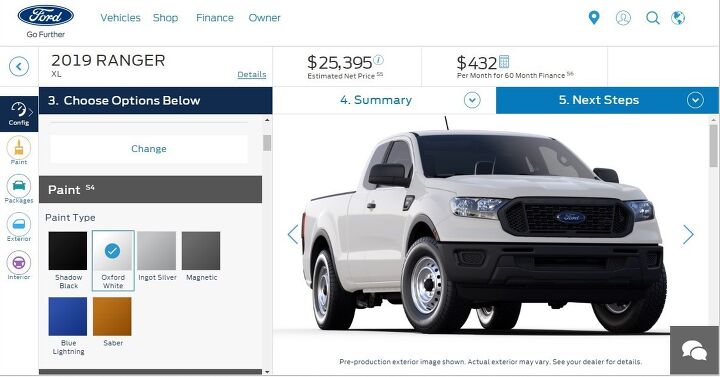The Ranger's No Cannibal, Ford Says

Good news: the Ford F-150 will not be discontinued as a result of the runaway popularity of the 2019 Ford Ranger. Phew.
As the Blue Oval readies its midsize pickup for a winter launch, Joe Hinrichs, head of global operations, claimed Monday that the automaker doesn’t expect much cross shopping among would-be Ford pickup buyers. Frankly, this would have only been a concern if buyers focused on a truck’s tow rating and nothing else. Still, Hinrichs felt it needed to be said.
Ranger folks are not F-150 folks.
“There always will be some substitution, but this is more of a lifestyle vehicle for people who want to use it for different purposes,” Hinrichs said at the Ranger’s Detroit-area plant ahead of production kick-off. “The F-150’s gotten bigger over time and more expensive. We believe there’s room now to slot the Ranger in very nicely in the showroom.”
Ford raised considerable ire in the TTAC den with its lofty pricing compared to other midsize options. A base Ranger SuperCab XL starts at $25,395 with destination, rising to just shy of the $30k threshold with four-wheel drive added. Moving to an XLT 4×2 requires an outlay of $29,035. Of course, the sky’s the limit for deep-pocketed buyers.
What Ranger buyers can’t count on at launch is helpful incentives, something 2019 F-150 buyers already have access to. Minus available incentives, a 2019 F-150 XL regular cab starts at $29,68 after destination. The SuperCab XL retails for $33,735. Looking to build from that entry-level starting point? Tack on $4,645 for four-wheel motivation, $995 for Ford’s sweet 2.7-liter EcoBoost V6, or $1,995 for a 5.0-liter V8.
F-150 buyers gain a substantial increase in real estate for their extra cash, which is why the bigger pickup will continue serving a replacement for the traditional family sedan. The lifestyle buyers Hinrichs envisions won’t see much of a decrease in towing capacity, as the Ranger’s turbo 2.3-liter four-cylinder provides enough oomph (270 hp, 310 lb-ft) to tug 7,500 pounds, just 200 lbs shy of the max rating of a base F-150 XL with 3.3-liter V6. That’s more likely to swing buyers from the Ranger’s midsize rivals.
Over the first nine months of 2018, midsize truck sales grew 18 percent in the U.S., despite the market’s overall stagnation.
[Image: Ford Motor Company]

More by Steph Willems
Latest Car Reviews
Read moreLatest Product Reviews
Read moreRecent Comments
- Ajla " China on Thursday encircled Taiwan with naval vessels and military aircraft in war games, as it vowed the blood of 'independence forces' on the self-ruled island would flow." Foreign ministry spokesman Wang Wenbin then delivered a warning that included language more commonly used by China's propaganda outlets."Taiwan independence forces will be left with their heads broken and blood flowing after colliding against the great... trend of China achieving complete unification," Wang told reporters.--------People can buy what they want but the mirrors still work in my house.
- AZFelix The younger demographic is also more likely to have a septum piercing. So there's that to consider when evaluating the profundity of their decision making.
- Haze3 The main advantages of this scheme would seem to be low/isolated pollution (single source NG) and high uptime. Electric is definitely better for net particulate at worker level and may also be preferred for long term maintenance.This said, the CA grid runs a little under 40% fossil fuel (pretty much all NG), so charging these trucks directly from the grid would have lower emissions than generating directly from 100% NG. It would also be more power efficient. However, it's likely that supply reliability and cost would be worse (this cuts out the power co). This is a LOT of charging.Overall efficiency should be equal to or a little worse than direct NG fueling, depending on NG generation process type. Should run 30-40% vs. 40% for direct NG fueling.
- Canam23 When I moved to France a little over two years ago, one of the first things I noticed is the French buy French... everything. Seven out of ten cars you see on the road are French. When you go to the Home Depot equivalent, almost all the products are French or European Union, even the food in the grocery stores is labeled as being produced in France. This probably isn't surprising from a country that makes its own airliners, fighter jets and submarines but coming from the US where so much is imported from outside and especially from China, this was a revelation. Does France have protective tariffs? Yes, but nothing over the top. The French are proud of their products and they enjoy their employment and the benefits they receive. They do sell a Chinese brand here, MG, and you get a bit more for your money, but not much.If Americans had the same attitudes as the French, there might be a lot more manufacturing jobs in the US.
- Fred Remember when "made in Japan" was cut? Face it people bought 10 year old Fiats made behind the iron curtain. People will always shop price, the rest be damned.



































Comments
Join the conversation
It's the new iFord XS. Perfect for kids and groceries or when the iFord XS Max is just too much. Soon to be available in the King Starbucks Ranchmart Depot Play Edition with lots of fun mocha frappe latte colors!!
"The F-150’s gotten bigger over time and more expensive. We believe there’s room now to slot the Ranger in very nicely in the showroom.” This seems like an odd thing for the head of global operations to say, because while it is technically true, the physical size difference between an old and new F-150 is less than the difference between an old and new Ranger: https://www.reddit.com/r/cars/comments/9pehn8/ ford_just_confirmed_that_there_will_be_no_ranger/e87p6tc/